Search the Special Collections and Archives Portal
Search Results
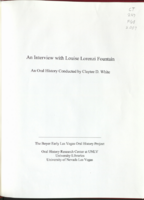
Transcript of interview with Louise Lorenzi Fountain by Claytee D. White, March 30, 2004
Date
2004-03-30
Archival Collection
Description
Louise Lorenzi Fountain was born on Nov. 14, 1913, to David Lorenzi, a French immigrant, and Julia Travese Moore from La Belle, Missouri. Her younger years were devoted to helping her father develop and manage Lorenzi Lake Park, which was built by Lorenzi and is considered a primary landmark in the development and life of the citizens of Las Vegas. Louise Lorenzi's father has been noted as one of the 100 most influential citizens of Las Vegas by the Las Vegas Review Journal. He opened the park in 1926 with a pair of man-made lakes and a swimming pool, dance hall, band shell and other amenities. In the interview, Louise talks about her father and mother and describes Las Vegas during its early years. Louise Lorenzi married Edgar Fountain in 1936. He had hitchhiked from Georgia in search of work on the construction of Boulder Dam, now Hoover Dam. The couple left Las Vegas for 10 years and lived in Grand Coulee, Washington, where he helped build Grand Coulee Dam. After returning to Las Vegas, Louise became a full partner in several business ventures the couple started. Those included the Nevada Amusement Co., a collection of 35 coin-operated phonograph machines; Frontier Radio and Appliance Co.; and later a television sales business; partnerships in two soft-drink bottling companies and a Toyota dealership. Louise Lorenzi Fountain was active in two Methodist churches and was a member of the First Presbyterian Church. She was a charter member and regent of the Valley of Fire Chapter of The Daughters of the American Revolution. Louise Lorenzi Fountain passed away on January 29, 2006 at 92 years of age.
Text
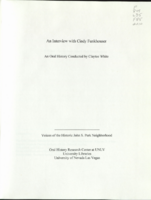
Transcript of interview with Cindy Funkhouser by Claytee D. White, January 14, 2010
Date
2010-01-14
Archival Collection
Description
Cindy Funkhouser grew up in the Midwest where she developed an early interest in "old stuff' as she refers to it. Her self-education in antiques spawned her business, Funk House, which she opened in 2001. Cindy is one of the forces behind the Downtown's arts movement and the development of First Friday, which was inspired by her observations of a similar event in Portland, OR. Cindy moved to Las Vegas around 1980. Her parents had moved to the valley in the late 1970s. When not working as a cocktail waitress at the Four Queens—a downtown casino where she was employed for 14 years—she pursued her interest in vintage items as a part-time business. Today others look to Cindy as a motivator for First Friday and the Las Vegas art movement that is deeply rooted in the John S. Park Neighborhood's sense of community.
Text
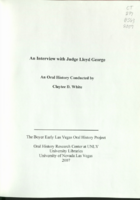
Transcript of interview with Judge Lloyd D. George by Claytee D. White, June 15, 2005
Date
2005-06-15
Archival Collection
Description
Judge Lloyd D. George was born on February 22, 1930, in Montpelier, Idaho. He attended grade school and high school in Las Vegas, Nevada, and earned his B.S. degree from Brigham Young University in 1955. Later that same year, He entered the United States Air Force and worked as a fighter pilot in the Strategic Air Command. In 1958, he concluded his military service as a captain. And in 1961, George earned his J.D. from the University of California at Berkeley. Judge George was admitted to the Nevada Bar in 1961 and began practice in Las Vegas. After 11 years in practice, he began on the path to Chief Judge: In 1974, he was appointed by the Ninth Circuit to preside over the United States Bankruptcy Court for the District of Nevada for a term of fourteen years. In 1980, Lloyd became a member of the Ninth Circuit Bankruptcy Appellate Panels and in 1984, President Ronald Reagan appointed him to the United States District Court for the District of Nevada. On July 15,1992, George was elevated to Chief Judge of the Nevada District. During his tenure on the bench, Chief Judge George held a variety of distinguished memberships. He was a board member on the Federal Judicial Center, a member of the National Bankruptcy Conference, the Chair of the Judicial Advisory for Bankruptcy Rules, the Chair of the Judicial Committee on Administration of Bankruptcy System, a Fellow at the American College of Bankruptcy, and a member of the Judicial Committee on International Judicial Relations. Judge Lloyd George is a highly respected figure in Southern Nevada and has given us a truly intriguing interview.
Text
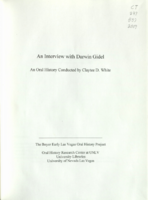
Transcript of interview with Darren Gidel by Claytee White, October 21, 2009
Date
2009-10-21
Archival Collection
Description
Darwin Gidel, born in 1924, grew up in Rockwell City, Iowa. He describes his childhood activities, schooling, and the jobs he held as a teenager. After graduating from high school in June of '42, Darwin immediately joined the military. His basic training took him from Minneapolis to Missouri, after which he was stationed in Nebraska, California, Florida, and South Carolina for further training. As he recalls his early military training, Darwin also evokes the patriotic fervor that gripped the country. He shares stories about the kindnesses he and many other enlistees received from individuals and families, ranging from rides to dinners to overnights. Darwin's overseas assignment was in London, England, beginning in November of 1943. He vividly recalls the bombing raids he flew and describes them from beginning to end. His B-l 7 was shot down over Belgium in March of 1944, and he and eight other crew members were held as POWs for eleven months. Much of Darwin's incarceration was in a Luftwaffe Hospital in Brussels, where his injured leg was removed. His memories include hospital personnel, solitary confinement, interrogation, and later being moved around to many different prisons in Germany. He clearly recalls relationships among prisoners, the configuration of German prisons, types of food served to inmates, and finally his repatriation from Annenberg Castle in Germany. After the war, Darwin earned a degree in accounting on the Gl Bill, which eventually led to general administration work in Sacramento. Along the way he married and had four children. After his wife passed away in the late seventies. Darwin eventually relocated to Las Vegas and remarried. He describes the city, recalls the small town atmosphere, and compares the impersonal bottom-line attitude of modem casinos to the folksy, welcoming feel of those establishments in the early eighties.
Text
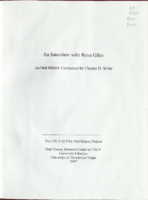
Transcript of interview with Reva Giles by Claytee D. White, July 17, 2006
Date
2006-07-17
Archival Collection
Description
Reva Giles grew up in the little town of New Carlisle, Indiana. She was one of twelve children, learning from an early age to share, to give and take, and to appreciate hand-me-downs. Her mother stayed home with the children, and her father worked for Studebaker, a large automobile manufacturer. Right after high school graduation, Reva moved to Redland, California, to live with a sister, working first at an ice cream place and then a bank. Reva married a military man, and she and their three sons followed him as he was transferred first to Las Vegas, then Okinawa, and finally Utah. When he retired in 1964, they returned to Las Vegas, where he went to work for Pete Findlay Oldsmobile. Their ' middle son Stuart played football at UNLV, and Reva got involved in fundraising and ticket sales for the team. Reva always enjoyed helping students, and from the ticket office she moved into admissions, and then student services. She worked for Drs. Ackerman and Burns helping to certify athletes, and from there went into career services, helping students find jobs and practice interview techniques. After Reva retired, Susie Smith asked her to come back and help, which Reva did gladly. She volunteers as an office aide to Susie as well as Mike Hamrick, athletic director at UNLV. Mike worked with Reva back in the eighties when he was a graduate student, and they have kept in touch through the years. Reva recalls the university campus when there were only two buildings, and was there for much of the new growth. She is familiar with the history of the Millennium Scholarship, the impact of Tarkanian's Runnin' Rebels on the community and school, and the North-South rivalry between UNLV and UNR's teams. Reva and her family have supported UNLV teams for many years, and she has many anecdotes concerning team trips.
Text
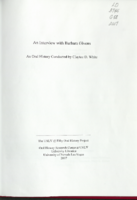
Transcript of interview with Barbara Givens by Claytee D. White, October 5, 2005
Date
2005-10-05
Archival Collection
Description
Barbara Givens was born in California, grew up in Reno, Nevada, and moved to Las Vegas in 1952 with her family when she was 14 years old. Her father ran a small construction business here in Vegas until he retired about 15 years ago. Her brother Steve and his children live in Vegas also. Barbara graduated from Las Vegas High School and enrolled in the first matriculated teacher's program at the Southern Regional Division of the University of Nevada at Las Vegas (now known as UNLV). Barbara was involved in organizing the first "Rebel Yell", school dances in Las Vegas, and other collegiate activities in Reno. In her senior year, she returned to Las Vegas High to complete her student teaching. After graduation, Barbara was assigned to Rancho High School to teach biology. She left after a year and a half because she had married and was expecting her first child. At that point in time, Clark County School District did not allow pregnant women to remain in the classroom. Fifteen years later she returned to the classroom, this time at Chaparral High. Concurrently, Barbara entered the Master's in Education program at UNLV, and graduated in 1980. Barbara has always loved to travel and has experienced many wonderful trips to exotic places around the world. In retirement, she assists with special events at Hamm Hall and Judy Bailey Theater, goes on-line to offer her services as a biology tutor to high school students, and continues to plan exciting trips abroad. She also indulges in her favorite hobby - attending Star Trek conventions and collecting Star Trek memorabilia.
Text
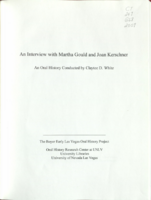
Transcript of interview with Martha Goulda and Joan Kerschner by Claytee D. White, October 26, 2005
Date
2005-10-26
Archival Collection
Description
Martha Gould and Joan Kerschner have been instrumental in most phases of library development in Nevada - from the branch to the state library. Their stories are fascinating and cover the techniques of moving a physical library to installing massive computer systems. They became librarians as young women and worked their entire careers in the field. Their memories add depth and profound meaning to the work of librarians. Gould grew up in a small mill town on the Sugar River and attended the University of Michigan. A librarian at Dartmouth College gave her a job and then insisted that she return to school for a master's degree. She earned her MS in Library Science from Simmons College. Kerschner hails from the Midwest, growing up in Abe Lincoln country. As a young girl, she went into their little Carnegie Library to rest and to view photographs on the stereograph while in town shopping with her family. She attended college across the river at Kentucky Wesleyan College and then earned a master's in library science at Indiana University. Martha and Joan have lobbied and testified before assembly committees to help bring libraries in Nevada to their current standing. This interview is about serious work told by two women, one who became state librarian, who look back over their many accomplishments with laughter and great joy.
Text
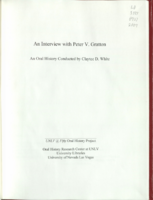
Transcript of interview with Peter Gratton by Clayee D. White, February 26, 2009
Date
2009-02-26
Archival Collection
Description
Peter Gratton was born in 1944 in Staten Island, New York, where his father was in the Coast Guard. However, he spent his childhood in Minnesota. From 1965 to 1969, Peter was a member of the US Marine Corps, serving a tour in Vietnam. As his military duty was ending, he learned that his parents were relocating to Vegas, bringing with them all of Peter's belongings. So Peter caught up with them in Vegas where he transitioned to civilian life in a new city by "bumming around for a couple of months." He decided to stay and took a keno job at Golden Gate Casino. In 1981, he graduated from UNLV and was accredit to teach history and earth science. This proved to be a good background for an opening at the UNLV library and he helped organize the map collection. With that, his UNLV library career was successfully launched. At the time of this interview, Peter was Administrative Assistant III Lied Library Building Department. In the following pages Peter tells of his experiences that lead up to becoming a Las Vegas resident and longtime member of the UNLV library staff.
Text
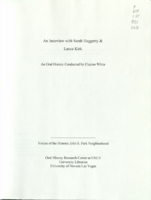
Transcript of interview with Sarah Haggerty and Lancy Kirk by Claytee D. White, February 2, 2010
Date
2010-02-02
Archival Collection
Description
Sarah Haggerty and Lance Kirk are a married couple with two small children. Both are born and raised Nevadans—he's from Reno and she's from Las Vegas. Sarah has deeply rooted memories of the John S. Park area, her paternal grandparents' home is there. As a couple, Sarah and Lance reflect on home ownership in both the Huntridge and John S. Park areas. Lance, an architect, talks about the house and the social communities. And ultimately asks the poignant question: Is the community making us or are we making the community? Sarah reminisces about the transition in the neighborhood, a transition that she feels began in the 1990s as the original owners aged and their homes were sold to a new generation of owners at a time when the greatest growth in the valley was to the suburbs. She may harbor nostalgic feelings, but she is also a realist: It's just different. We face different challenges but we have different rewards too, she says.. Among the most significant changes is the increased Hispanic demographic, which she guesses to be nearly 50%. They talk about the challenge of getting these residents more involved in the community's social and activist causes. About crime, they observe that is isn't necessarily higher, but it is affected by the homeless population that gravitates there. Their wish list includes: sidewalks, parks, community centers, more restaurants. However, none of this discourages their love of living in John S. Park. They have been actively involved in projects that draw the community together, from door knocking to using social networking to assist those efforts.
Text
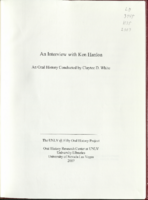
Transcript of interview with Ken Hanlon by Claytee D. White, November 29, 2006
Date
2006-11-29
Archival Collection
Description
Ken Hanlon was born in Baltimore, Maryland, in 1941. He attended 2nd grade through high school in Parkville schools. He took up his first instrument, the snare drum, at the age often, and by eighth grade had taken up baritone horn and trombone. His parents were very supportive of his interests. Ken developed a very strong work ethic early on, through the influence and example of his parents. He earned money in high school to pay for things he wanted by assisting on a paper route. He also took private lessons, which he paid for, and played in a dance band. After graduation, he attended Peabody Conservatory on a scholarship. He finished his last two years there with the principal of the Baltimore Symphony. He taught at Peabody Preparatory for seven years as undergraduate and graduate. He continued his Master's degree at Peabody Conservatory while working as a public school instrumental music teacher. He also played in the rock and roll band and worked in a city concert band. In 1968, Ken and his family moved to Las Vegas. He connected with the Si Zentner band and went on the road with him, then played in hotels up and down the Strip. Ken worked in bands that backed many famous headliners and has many anecdotes and memorable stories to share about those days. In 1970, Ken interviewed with Howard Chase, chair of the music department at UNLV. He was hired and his first UNLV job at the age of 29 was chair of the music department. He kept this position for 16 years, with one year off to establish residency for his doctorate. Dr. Hanlon has had a long and varied career, filled with people, places and events vital to the music industry. Today he continues to teach a graduate course, is currently Las Vegas president of the International Trombone Association, and runs the Arnold Shaw Popular Music Research Center.
Text
Pagination
Refine my results
Content Type
Creator or Contributor
Subject
Archival Collection
Digital Project
Resource Type
Year
Material Type
Place
Language
